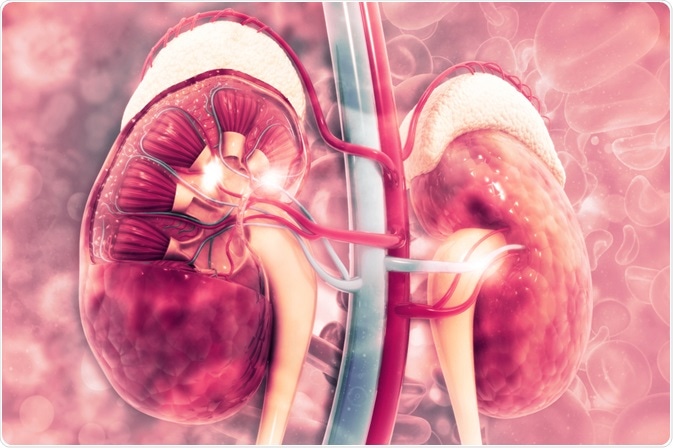Chronic kidney disease (CKD) is often asymptomatic and discovered through routine blood tests and urinalysis. These tests can also be used to screen for early changes in specific populations at risk of developing CKD. In addition, urinalysis can provide valuable information about other characteristics of renal function, such as the presence of blood or protein in the urine.

Image Credit: crystal light / Shutterstock.com
Screening
Some individuals are at a higher risk of developing CKD and, as a result, should be screened regularly for early signs of the condition so that they can receive timely treatment.
Annual screening of CKD is recommended for people with:
- Hypertension
- Diabetes
- Acute kidney injury caused by medications such as lithium or nonsteroidal anti-inflammatory drugs (NSAIDs)
- Cardiovascular disease
- A family history of inherited or stage five CKD
- Systemic lupus erythematosus (SLE)
- Hematuria
- Proteinuria
Outside of these at-risk population groups, there is no evident need to screen for compromised kidney function in the general public. In many cases, routine blood or urine tests will detect changes and indicate any abnormal function of the kidneys. If there is a positive result, the test should be repeated to confirm the diagnosis.
Glomerular filtration rate
The estimated glomerular filtration rate (eGFR) is a useful indicator to assess the function of the kidney, specifically the volume of blood filtered per minute. A healthy person typically filters at least 90 milliliters (mL)/min; therefore, a filtration rate below 60 mL/minute usually indicates that there are significant changes in kidney function.
The concentration of creatinine in the urine is measured and the value can be calculated using a formula that takes into account the individual’s age, gender, and ethnic group. The albumin:creatinine ratio can also be used to estimate GFR.
Diagnostic staging
There are six stages of CKD based on the eGFR that are used to indicate the progression of CKD and help guide the treatment recommendations.
- Stage 1 (G1): Normal eGFR (>90 mL/min) with evidence of kidney damage from other tests.
- Stage 2 (G2): Slightly decreased eGFR (60-89).
- Stage 3a (G3a): Mildly decreased eGFR (45-59) with mild to moderate decrease in kidney function.
- Stage 3b (G3b): Moderately decreased eGFR (30-44) with moderate to a severe reduction in kidney function.
- Stage 4 (G4): Severely decreased eGFR (15-29) with a severe reduction in kidney function and possible symptoms evident.
- Stage 5 (G5): Severely decreased eGFR (<15) and referred to as renal failure.
For individuals with stage 1 or stage 2 CKD, there is not usually a need for treatment. However, the condition should be carefully monitored with regular eGFR tests to detect any changes.
Individuals with stage 3a CKD have a mild to moderate decrease in kidney function and should be tested annually to monitor for any changes. Those with stage 3b or stage 4 CKD have moderate to severe reduction and should be tested more often and at least once every six months. Patients with stage 5 CKD have severely compromised renal function and should be tested for changes every three months.
It is worth noting that the eGFR can fluctuate over time; therefore, if an abnormal test result is obtained, repeating the test may yield a different result. For this reason, a diagnosis of CKD is usually confirmed with a series of tests that are conducted over a period of about three months.
Stages of Kidney Disease
Imaging tests
There are several diagnostic imaging tests that may be able to help in the diagnosis of CKD and identify any structural abnormalities or obstructions in the urinary flow. This is particularly important to investigate the presence of an enlarged prostate gland in men.
Magnetic resonance imaging (MRI), computerized tomography (CT), and ultrasound scans may all be beneficial in the diagnostic process in some cases.
Kidney biopsy
In some cases, a biopsy of the kidney tissue may need to be taken. This can be sent to a laboratory where it is examined under a microscope for damage that may be affecting the function of the kidneys.
References
Further Reading